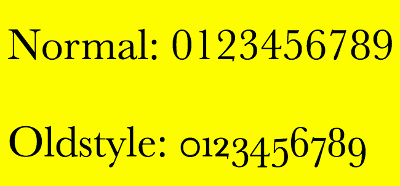CSS font-variant-numeric
The font-variant-numeric property allows you to specify control over numerical forms.

The above code example should look like this image. If it doesn't, your system probably doesn't have an oldstyle version of the numeric glyphs.
The font-variant-numeric property was one of the properties introduced in CSS3 for enabling various font related features that can improve the appearance of the text on the page. The font-variant-numeric property deals specifically with numeric forms.
Syntax
The syntax of the font-variant-numeric property is:
These values are explained in more detail below.
Possible Values
normal- Specifies that none of the features below are enabled.
- numeric-figure-values
-
This can be one of the following values:
lining-nums- Enables display of lining numerals (OpenType feature:
lnum). oldstyle-nums- Enables display of old-style numerals (OpenType feature:
onum).
- numeric-spacing-values
-
This can be one of the following values:
proportional-nums- Enables display of proportional numerals (OpenType feature:
pnum). tabular-nums- Enables display of tabular numerals (OpenType feature:
tnum).
- numeric-fraction-values
-
This can be one of the following values:
diagonal-fractions- Enables display of lining diagonal fractions (OpenType feature:
frac). stacked-fractions- Enables display of lining stacked fractions (OpenType feature:
afrc).
ordinal-
Enables display of letter forms used with ordinal numbers (OpenType feature:
ordn). slashed-zero-
Enables display of slashed zeros (OpenType feature:
zero).
In addition, all CSS properties also accept the following CSS-wide keyword values as the sole component of their property value:
initial- Represents the value specified as the property's initial value.
inherit- Represents the computed value of the property on the element's parent.
unset- This value acts as either
inheritorinitial, depending on whether the property is inherited or not. In other words, it sets all properties to their parent value if they are inheritable or to their initial value if not inheritable.
General Information
- Initial Value
normal- Applies To
- All elements
- Inherited?
- Yes
- Media
- Visual
- Animatable?
- No
Example Code
Official Specifications
- CSS Fonts Module Level 3 (W3C Candidate Recommendation 3 October 2013)
Vendor Prefixes
For maximum browser compatibility many web developers add browser-specific properties by using extensions such as -webkit- for Safari, Google Chrome, and Opera (newer versions), -ms- for Internet Explorer, -moz- for Firefox, -o- for older versions of Opera etc. As with any CSS property, if a browser doesn't support a proprietary extension, it will simply ignore it.
This practice is not recommended by the W3C, however in many cases, the only way you can test a property is to include the CSS extension that is compatible with your browser.
The major browser manufacturers generally strive to adhere to the W3C specifications, and when they support a non-prefixed property, they typically remove the prefixed version. Also, W3C advises vendors to remove their prefixes for properties that reach Candidate Recommendation status.
Many developers use Autoprefixer, which is a postprocessor for CSS. Autoprefixer automatically adds vendor prefixes to your CSS so that you don't need to. It also removes old, unnecessary prefixes from your CSS.
You can also use Autoprefixer with preprocessors such as Less and Sass.